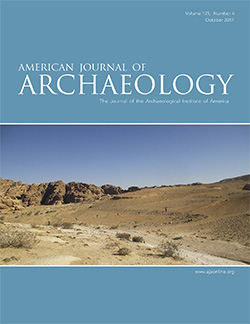AJA Open Access
BY-NCOctober 2017 (121.4)
Book Review
The Archaeology of Urbanism in Ancient Egypt: From the Predynastic Period to the End of the Middle Kingdom
By Nadine Moeller
Reviewed by Hannah Pethen
Moeller’s thorough survey of Egyptian towns and cities, their development, and urban aspects from the Predynastic period to the Middle Kingdom (ca. 5300–1650 B.C.E.) is the first book to address in depth the earliest phases of urbanism in ancient Egypt and to synthesize a considerable body of recently excavated archaeological evidence from these periods. It provides persuasive support for her argument that ancient Egypt was an inherently urban civilization and succeeds in creating a suitable foundation for further research into and cross-cultural comparisons of ancient Egyptian urbanism and settlement archaeology.
This book follows broader but less detailed considerations of settlement archaeology (e.g., S. Snape, The Complete Cities of Ancient Egypt [London 2014]) and detailed but chronologically restricted research (e.g., M. Bietak, ed., Haus und Palast im Alten Ägypten [Vienna 1996]). It clearly owes much to Kemp’s (Ancient Egypt: Anatomy of a Civilization [London 2006]) archaeologically grounded synthetic and diachronic research, as well as the typological approaches of Bietak (e.g., “Houses, Palaces and the Development of Social Structure in Avaris,” in M. Bietak, E. Czerny, and I. Forstner-Müller, eds., Cities and Urbanism in Ancient Egypt [Vienna 2010] 11–68). Moeller is explicit about the theoretical foundations of her research, discussing her approach, the definition of “urbanism” (ch. 1), and how urbanism might be identified archaeologically. She rejects Eyre’s (“The Village Economy in Pharaonic Egypt,” in A. Bowman and E. Rogan, eds., Agriculture in Egypt: From Pharaonic to Modern Times [Oxford 1999] 33–60) and Lehner’s (“Villages and the Old Kingdom,” in W. Wendrich, ed., Egyptian Archaeology [Oxford 2010] 85–101) view of Egyptian civilization as a “village society” and follows Trigger’s (Understanding Early Civilizations [Cambridge 2003] 131–32) understanding of urbanism as culture-specific and defined by “urban society” rather than settlement size.
Moeller’s timely research relies on the large number of settlement sites excavated to a high standard over the last 40 years (ch. 2). As a result, one of the great strengths of this book is its broad focus on the full range of excavated Egyptian settlements from elite “mansions” and governors’ palaces to the smallest houses, and from famous settlements to the least publicized remains. This range ensures that, as far as is possible given the current evidence, the conclusions drawn cover the full breadth of early Egyptian urbanism, taking account of variation across geography, social classes, and changing political forces. The variety of sites covered enables the author to elucidate similarities that reflect the social dynamics of Egyptian civilization, such as the “interconnectedness” of all levels of urban society, the importance of core forms or “modules” in house construction, the tension between statist redistribution and private provision, and the prevalence of “multifunctionality,” from individual rooms to whole houses (377–80). By studying urbanism across the earlier periods of Egyptian history, Moeller contributes to our understanding of the dynamics of Egyptian civilization during its earlier phases and exposes the conceptual origins of later, better-known Egyptian settlements.
The book is organized chronologically to facilitate interpretation of the development of Egyptian urbanism; where relevant, change is also considered in light of appropriate political or regional differences. This results in a certain amount of repetition when a site provides information from multiple periods, but it allows Moeller to identify diachronic trends, such as the relatively unstable nature of state foundations compared with organic towns, particularly during the First Intermediate Period (ca. 2160–2055 B.C.E.). The author also makes a welcome attempt to consider the role of geography and provincial life in the development of urban forms, although her ability to derive truly persuasive conclusions is somewhat limited by the patchy nature of the evidence. Moeller is sensitive to these limitations and presents them in a transparent way throughout the book so the reader is left with no doubt as to their potential impact on her conclusions.
Moeller bases her research on two different typologies: the categorization of settlements (ch. 1) and a typology of Middle Kingdom houses (ch. 9). At times her categories feel forced in comparison with her careful analysis of the excavated evidence, and she sometimes fails to recognize where different “types” are actually points on a continuum. While she classifies Lahun and Wah Sut as “state foundations of urban character” that were intended to service the mortuary cults of the pharaohs, it is clear from her detailed analysis that Lahun is much closer to the category she defines as a “provincial capital” than Wah Sut, revealing how fluid these categories can be (296). However, although one might quibble with its strict details, the categorization is undoubtedly a helpful tool for organizing such a broad spectrum of data, and thanks to the author’s careful and detailed presentation of the archaeological evidence, it is eminently possible for readers to draw their own conclusions about the categories and the relationships between them.
While it is possible to argue with some of Moeller’s interpretations, the importance of this work is guaranteed by the range of historical periods and sites covered and the focus on earlier, less thoroughly investigated phases of Egyptian settlement archaeology. The consistent, detailed analysis of the archaeological data, with due consideration for their limitations as well as their archaeological and environmental context, means that even those who disagree with the author’s conclusions or argument will find the synthesis of such a large body of archaeological data useful. Overall, this book is a timely addition to current research into ancient Egyptian settlements, cities, and urbanism, and it will be of interest to both experts and students. It provides the first full synthesis of the evidence for Egyptian urbanism from the earliest periods and represents a valuable and much-needed foundation for future fieldwork, interrogation of the existing data, cross-cultural comparisons, and academic debate about the nature of ancient Egyptian settlements and society.
Hannah Pethen
University of Liverpool
hpethen@gmail.com
